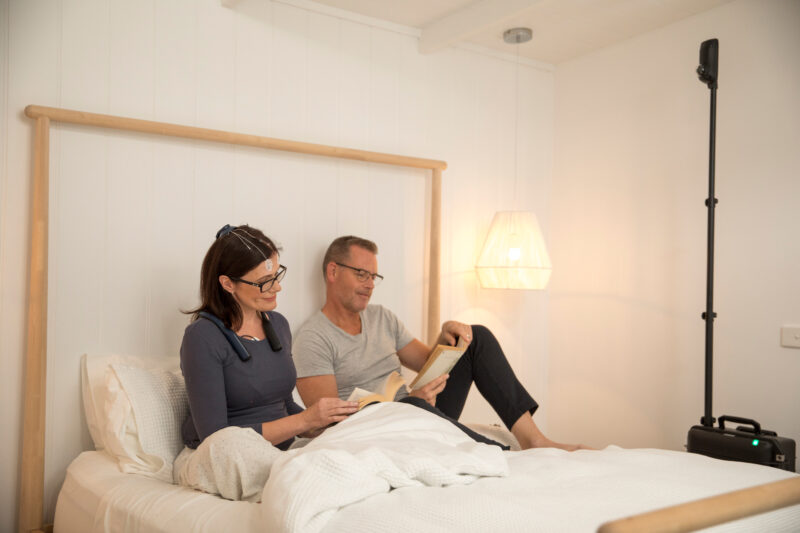Video-EEG monitoring is a comprehensive test used to diagnose seizures. It combines EEG recording (EEG, electroencephalogram, measures what’s happening in the brain) with video recording, and in most cases also includes ECG recording (ECG, electrocardiogram, measures what’s happening in the heart).
Previously, video-EEG was only available through the hospital, but is now widely accessible through Seer Medical’s home-based diagnostic service.
There are several types of testing available for diagnosing seizures that can be as short as 20 minutes or as long as two (2) weeks. For everything you need to know about EEG tests, read more in this article here.
Explaining the terms
The following terms are sometimes used interchangeably to refer to the same multi-day test that is completed in hospital — usually in an epilepsy monitoring unit (EMU) — or in the home.
- Long-term monitoring describes monitoring that lasts more than 24 hours
- Ambulatory monitoring or ambulatory EEG (sometimes written as AEEG) describes the use of portable and wearable EEG monitoring devices, allowing the person being tested to move freely during monitoring
[Blog] Why is video used to diagnose seizures?

[Image description: A patient is lying down and wearing multiple electrodes on their head, which record the brain’s electrical activity. A doctor is holding a clipboard and recording information, while the mother observes.]
Hospital or Seer Medical?
Whether you get referred for hospital testing or at-home testing will depend on your doctor’s recommendation as some cases require hospital testing.
Hospital monitoring is commonly preferred when:
- Daily check-ins by a doctor or medical staff are required
- Testing the effects of reduced seizure medication is required
- Sleep-deprived monitoring is required
- Pre-surgery evaluation is required
Your doctor will know best about which testing option is most suitable for you.
Here’s a breakdown of the differences between completing video-EEG in hospital and monitoring with Seer Medical.
| Hospital | Seer Medical | |
| Accessibility | ||
| Waitlist | 6 months – 1 year* | 4-6 weeks^ |
| Location | Epilepsy monitoring units (EMUs) usually only in major cities | Clinics in all major cities and in several regional areas |
| Living conditions | ||
| Location | Stay in hospital | Connection at a Seer Medical clinic, then stay at home for monitoring |
| Family & Visitors | During visiting hours** | Be with your family at home and have flexibility to have visitors at any time |
| Freedom of movement | Limited.
Most EMUs require patients to remain in bed for the duration of their monitoring |
Free to move around within view of the camera |
| Sleep | In a hospital bed | In your own bed |
| Bathing/showers | Sponge bath or light wash allowed.No bathing or showers. | Sponge bath allowed with belt system.
Showers allowed with Sense and harness systems |
| Supervision | One (1) accompanying person required at all times | Recommended, but not required for those who do not normally require supervision or caretaking |
| Testing conditions | ||
| Video | Yes — Affixed to ceiling of hospital room | Yes — Set up in room of choice and can be moved when needed |
| EEG | Yes | Yes |
| ECG | Yes | Yes |
| Electrode adhesive | Collodion only | Collodion
WaterTabs® — Based on availability and suitability |
| Self-disconnection | No | Yes — With WaterTabs® |
| Reliability of testing | The unfamiliar hospital environments can be difficult for people with learning difficulty or with challenging behaviour, leading to unsatisfactory video-EEG recording in hospital1 | Video quality of home monitoring is comparable to in-patient monitoring, and in some cases, is found to be superior to in-hospital video quality2.
EEG/ECG data quality is the same as in-patient data quality3 |
| Technical support | Usually 24/7 with staff on site | Phone support available
Monday to Friday — 9:00am-10:00pm AET (Melbourne/Sydney) Saturday and Sunday — 9:00am-5:00pm AET (Melbourne/Sydney) |

[Image description: A couple is sitting in bed together and both reading books. The woman is undergoing monitoring and wearing Sense EEG-ECG wearable device. The video camera is in the corner of the room.]
How to prepare for video-EEG
Whether you’re completing monitoring in the hospital or in the home, there are a few things you can do to prepare for your test.
- Wash your hair the night before or the morning of so it’s clean and dry
- Wear a button-up or loose-fitting shirt to make it easier to attach chest electrodes
- Have entertainment such as books, puzzles, knitting, games or movies on hand
- Have wet wipes to freshen up
If you’re completing video-EEG-ECG monitoring with Seer Medical, you might find this checklist helpful for preparing your home:
[Blog] How to prepare your home for monitoring (Downloadable PDF)
If you have any questions about monitoring with Seer Medical click below or get in touch to speak with our friendly staff.
*Waitlists vary depending on the hospital and may be longer due to COVID-19.
^4-6 weeks waitlists for permanent clinics. Waitlists for visiting clinics are dependent upon referral numbers and the demand. Please see our website or contact us for more information
**Visiting hours and conditions vary depending on the hospital
1 Brunnhuber, F. et. al, (2020) Past, Present and Future of Home video-electroencephalographic telemetry: A review of the development of in-home video-electroencephalographic recordings, Epilepsia, 61(1), https://doi.org/10.1111/epi.16578
2 Biswas, S., Luz, R., & Brunnhuber, F., (2016) Home Video Telemetry vs inpatient telemetry: A comparative study looking at video quality, Clinical Neurophysiology Practice, 1, 38-40, https://doi.org/10.1016/j.cnp.2016.05.001
3 Kandler, R., Ponnusamy, A., & Wragg, C. (2017) Video ambulatory EEG: A good alternative to inpatient video telemetry?. Seizure, 47, 66-70. https://doi.org/10.1016/j.seizure.2017.02.010

